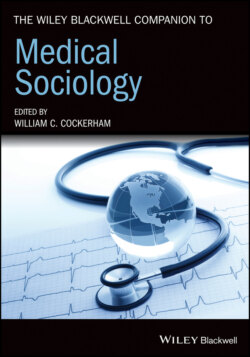Читать книгу The Wiley Blackwell Companion to Medical Sociology - Группа авторов - Страница 51
Strategies for Estimating Causal Effects
ОглавлениеIn broad terms, there are three strategies for estimating causal effects that involve (1) conditioning on confounders, (2) identifying instrumental variables, or (3) specifying mechanisms. The first, and by far the most commonly used, involves conditioning on all confounders in a statistical model. For instance, it is likely that mother’s education predicts both whether a mother smokes and the birthweight of her child. In this case, if we do not adjust for mother’s education in our analysis of smoking and birthweight, then we would likely overestimate the causal effect of smoking on birthweight, as part of the effect is likely due to mother’s education as a common cause of both. As noted above, a failure to incorporate all confounders in an analysis leads to biased estimates of causal effects. Well-articulated causal graphs allow researchers to identify the confounders that need to be included in an analysis. In practice, we never have measures of all possible confounders available, and therefore we need to rely on sensitivity analyses and/or more modest statements about our findings with respect to estimating causal effects.
The second strategy involves identifying an exogenous source of variation in the focal independent variable and often using statistical models based on instrumental variables. An exogenous source of variation refers to some feature of the world that induces a change in the focal independent variable for at least some cases but is otherwise unrelated to the outcome. Quasi-experiments fit into this category. Natural disasters can certainly cause changes in people’s lives that may be otherwise unrelated to an outcome or policy-oriented changes can fulfill the same role. To give an example, some studies in medical sociology have leveraged changes in compulsory schooling laws to try to estimate the effect of education on health (Courtin et al. 2019). A source of exogenous variation can be treated as an instrumental variable, i.e. a variable that has an effect on the focal independent variable but not the outcome.
The third strategy, and least commonly used, involves (1) specifying all of the mechanisms that link a focal independent variable to an outcome, (2) estimating the effects of each mechanism, and then (3) adding up the effects to get a total causal effect. A mechanism refers to the process through which a variable has an effect on an outcome. If we return to the education and health example, there are a number of mechanisms thought to account for the positive relationship. To name a few, higher levels of education lead to better and higher paying jobs, which can be used to support health. Higher levels of education also come with greater knowledge of health promoting behaviors and how to navigate the health care system. In addition, higher levels of education tend to expose people to similarly more highly educated peers who might in turn reinforce health promoting behaviors. Each of these processes can be thought as one of the mechanisms linking education to health. As this example might suggest, however, such an approach is quite challenging. We rarely know all of the mechanisms linking a focal independent variable to an outcome, and even in cases where we might have a good grasp on all of the mechanisms, we often do not have measures for each.
With respect to causal research questions, the counterfactual framework provides a powerful approach to understanding the possibilities available for causal analysis with observational data and the assumptions needed to support a causal interpretation. The regression models described for descriptive outcomes are routinely used for causal analysis as well. The details of the research design (e.g. Are key confounders measured? Are there exogenous sources of variation?) dictate whether a causal interpretation is warranted.
